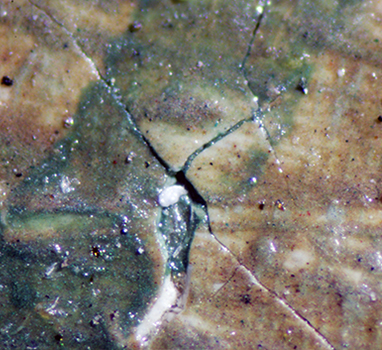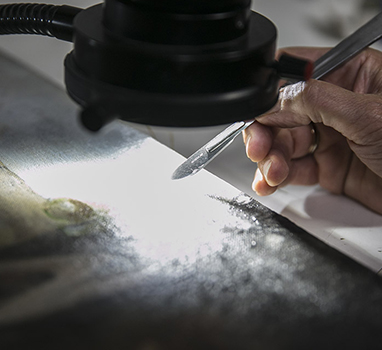MICROSCOPICAL EXAMINATIONS

Karl Ceiss- CL 1500 Eco
STERO MICROSCOPE
Surface examination
Besides multispectral photography, micrographs are taken as well with a camera applied to a stereo microscope. That makes possible to record the process of examination on the surface, while taking photographs too.
The main goal of microscopic analyses is to examine the rigidity of the surface, the aging cracks or the signature of the painting. Artificially aged surfaces, posterior signatures or even additional paint layers beneath are easily identifiable with this method.

Forged signature
If the paint of the signature ran into the original aging cracks, it is most likely forged. The originality of a signature can be supposed if it had cracked together with the paint layers. Aging cracks in case of an average oil painting are formed in c. 40 years.

The aging cracks
A natural property of paintings is the cracking of paint layers with time, because paints are drying due to oxidation. Consistent aging cracks (depth and frequency of cracks etc.) show if the artwork had been retouched, restored later. In case it is consistent everywhere, all parts of the painting were made in the same time. Properties of the aging cracks help in the dating process as well as in determining the age of the signature and the paint layers – examining it thoroughly is essential.

Sampling
The staff of the laboratory can take small samples from the paint layers or the grounding of a painting. These samples are almost invisible to the naked eye, they are analysed under a PLM microscope. There are two types of sampling, one is to prepare a cross-section, the other is grain sampling to analyse the size, shape and spreading of the used pigments.

Carl Zeiss Axioscope (PLM)
POLARIZED LIGHT MICROSCOPY (PLM)
Pigment grain analysis
Polarized light microscopy analyzes the pigments which give colour to the painting – their size, composition, shape can indicate the age of the artwork, controlling the results of the non-destructive examinations. We are taking photographs of samples taken from certain spots at 1000-2500x magnification; in normal, transmitted and reflected light. Sampling spots are chosen based on XRF results. During the process grains of pigments are taken from the surface of the painting, placed on slides embedded into Canada balsam. Identifying pigments is crucial in the process of dating an artifact – pigments such as Prussian blue (since c. 1720), titanium white (c. 1924), cerulean blue (c. 1860) can prove or disprove the supposed artist.

Normal photograph of pigment grains under plane-polarised light (1000x magnification)
The size, spreading and behaviour of pigment grains helps to draw conclusions for the dating process.

Pigment grains in cross-polarized light (1000x magnification)
Some of the optical and formal properties of the grains become observable in polarized light.

Pigments grains in reflected polarised light (1000x magnification)
The silhouette of pigment grains becomes observable in reflected light.
Analyzing cross-sections
In most cases, cross-sectional sampling is used to analyze the layers of overpainted paintings, in which the entire section of the structure is analyzed from the ground layer to the top varnish. Varnish between the paint layers or the identified individual use of materials can provide a lot of new information about the painting, and it can also help in the colour reconstruction of a black and white radiograph image about a painting underneath the visible one.

Cross section under plane-polarised light (100-200-400x)
During the cross-sectional sampling, an area of about 1 × 0.5 mm is taken from the surface of the painting and then analyzed after preparation. It makes well-observable not only the ground layer, but also the superimposed colourful paint layers and the varnish layers of the artwork.

Cross section under blue light filter
Certain organic substances already react to the inducement of blue light (resembling to UV light), thus this illumination with c. 400 nm blue light provides a preliminary result compared to the analysis of materials.

Cross section under UV luminescent light
The particles and materials in the samples are induced by UV luminescent light, thus organic components such as the old, oxidized varnish layer or inorganic pigments which luminesce in a peculiar colour are well-observable.

